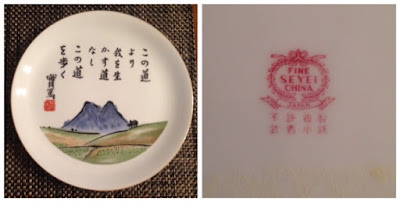I come upon many tops, and I come across many things with missing tops. The sad part is they do not match. I have found that a grouping of tops can make a lovely display. Here are some of mine. They are from different time periods and a couple may be Chinese.
Monday, June 22, 2015
Thursday, June 18, 2015
Seyei China (セーエー陶器) Porcelain of Aichi Prefecture
Seyei Fine China is made in Seto City, Aichi Prefecture JAPAN. The Seto area produces much of the tableware for JAPAN, in fact the Japanese sometimes refer to tableware as Setomono, or things from Seto.
This is from a mail order catalog dated 1962-1963 (from the collection of P. Rodriguez)
This is from a mail order catalog dated 1962-1963 (from the collection of P. Rodriguez)
This lovely display plate has the work of Saneatsu Mushanokoji. He was a poet, painter and novelist who lived from 1885-1976. This plate is considered "Showa Retro" so was probably made in 1960's or 1970's. The translated poem goes:
"From this road
There is no road I can go
I walk this road"
Monday, June 15, 2015
HASHIOKI (chop stick rests)
HASHIOKI are chopstick rests. They make a table setting a bit more formal. They come in all shapes and sizes. They can be made plain, ornate or fanciful. They can be made in ceramic, lacquer, wood or washi paper.
Top: Five little roosters
Bottom: The always popular "Maneki neko" is portrayed here as peas in a pod.
I love this set. It is fanciful.
These are Koda YAKI by the Agano Kiln.
Subscribe to:
Posts (Atom)
Featured Post
Helpful Vocabulary When Researching Japanese Ceramics
Vocabulary when searching for Japanese Ceramics *I will be adding to this list Dating ( 江戸) Edo Period (1603-1868) (江戸 前期) Ea...
-
From 1921-1941, wares from Japan exported to the United States had to be marked "Japan" or "Made in Japan". During Wor...
-
Kutani ware is from Ishikawa Prefecture. The markings are often in red, but can be impressed, in blue, gold and sometimes black with a g...
-
The This company was in business from 1954-1994. It was bought out by Enesco in 1994. Registered in NYC and San Francisco. Recognized by it...





















